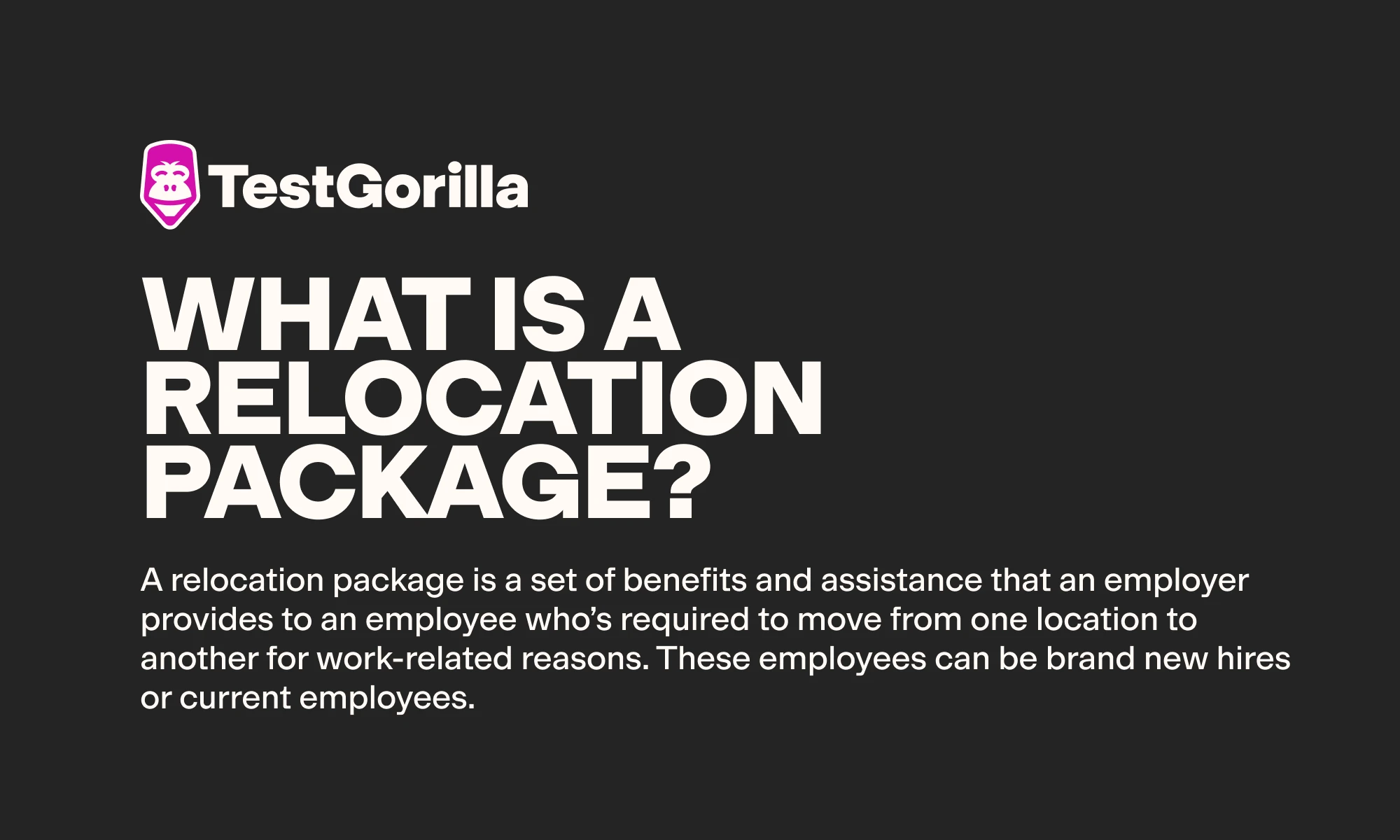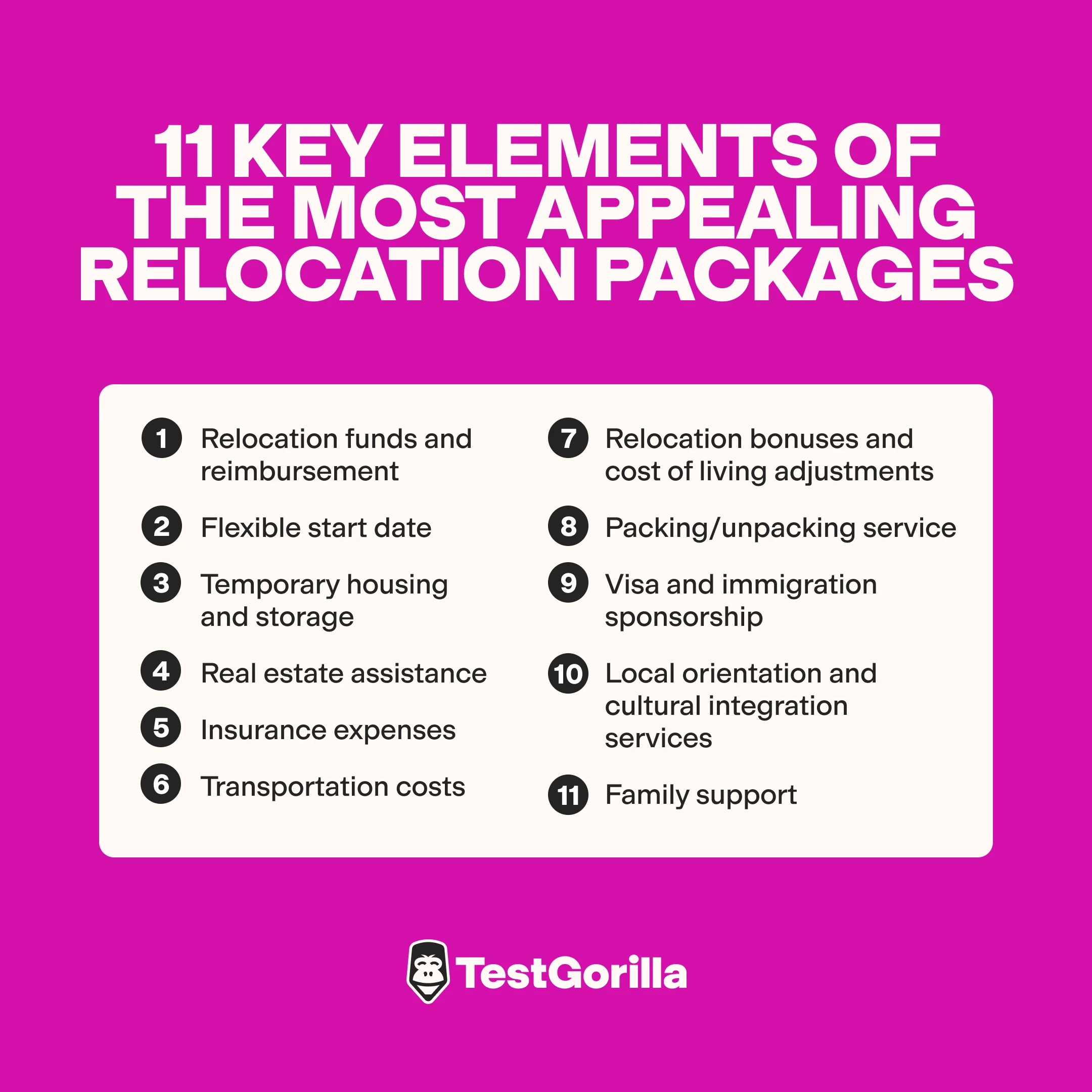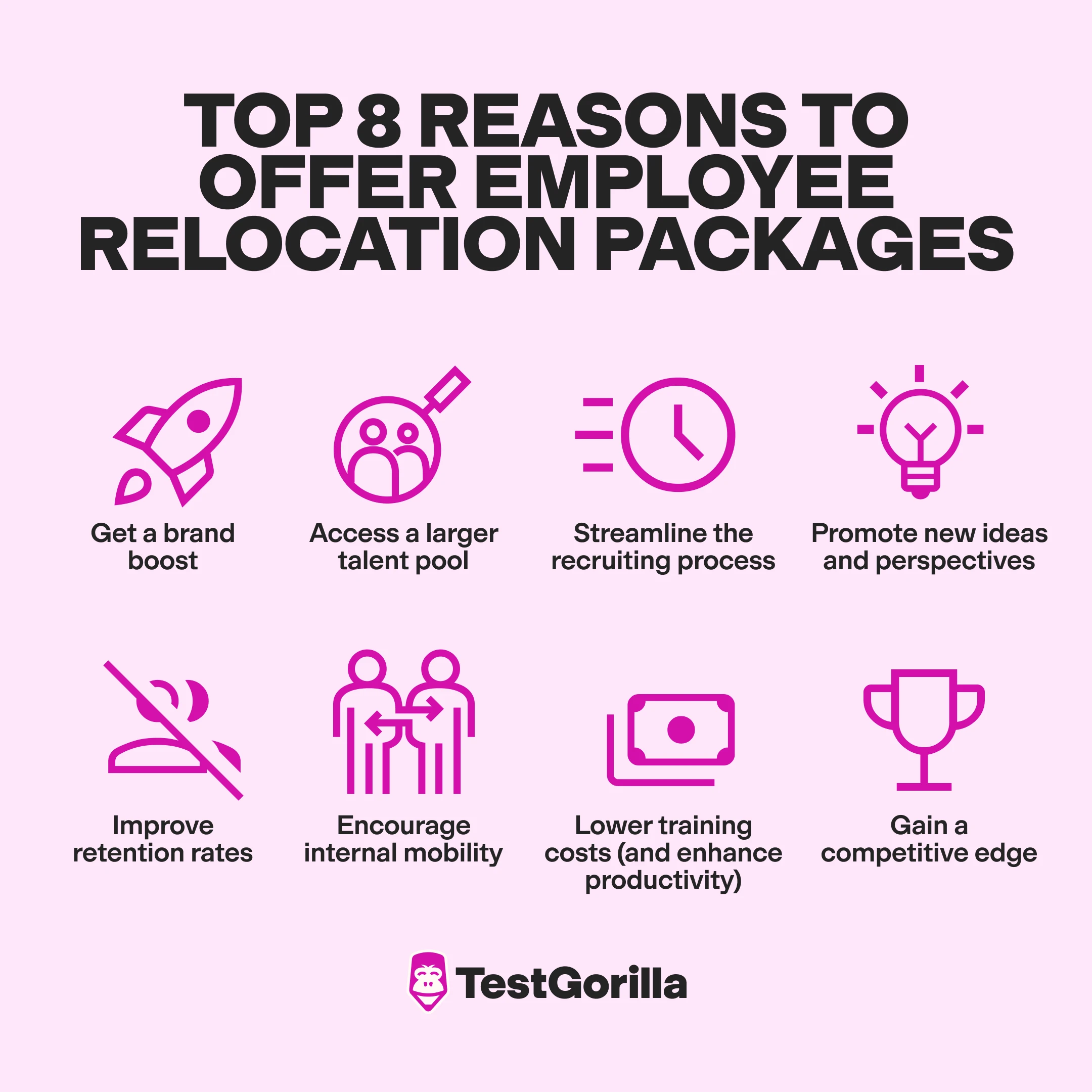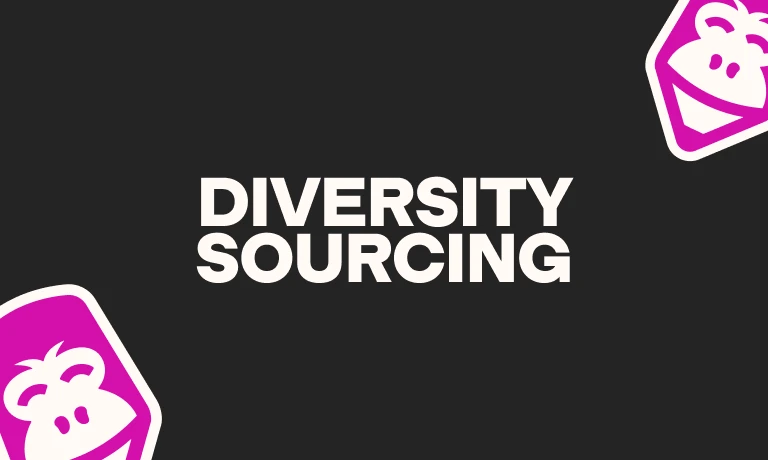Employee relocation packages and assistance: A comprehensive guide
As businesses continue to grow their operations in-country and internationally, employee relocation has become essential. Plus, with the growing preference for remote/hybrid work and the prevailing skills shortage, relocation packages are becoming ever more popular for attracting and retaining skilled talent.
That said, nailing down the perfect relocation package is a balancing act: You must consider your candidates’ and employees’ varied needs, as well as your company’s resources and goals.
In this article, we discuss what relocation packages and assistance entail, how a typical relocation package works, and best practices for crafting effective relocation packages.
Table of contents
- Key takeaways
- What is a relocation package?
- How do relocation packages work?
- 11 key elements of a great relocation package
- How much does an employee relocation package typically cost?
- Top 8 reasons to offer employee relocation packages
- 4 employee relocation package drawbacks and how to combat them
- 10 ways to set up and optimize your employee relocation packages
- Make skills assessments an integral part of your relocation package
- FAQs
Key takeaways
A relocation package provides benefits to employees moving from one area to another. These benefits are usually outlined in a company’s relocation policy.
Relocation packages typically include cost reimbursements and various allowances covering the cost of travel, housing, and family-related expenses.
There are various reasons employers should offer relocation packages, including enhancing internal mobility, accessing a larger talent pool, and gaining a competitive edge.
Skills assessments are a great way to screen candidates and feel confident that any new hires you relocate have the qualities they need to succeed in the position.
What is a relocation package?
A relocation package is a set of benefits and assistance that an employer provides to an employee who’s required to move from one location to another for work-related reasons. These employees can be brand new hires or current employees.
Relocation packages are designed to help alleviate the financial, logistical, and emotional burdens associated with moving to a new city, state, or country for a job.
A relocation package is an optional benefit, and the specific components of this package can vary widely based on the employer's policies, the employee's job level, and the distance of the move.
When do employers use relocation packages?
Typically, employers will offer relocation packages when they're transferring existing employees to new or existing company locations. They’ll also relocate new hires who have the expertise they need but live elsewhere and are needed for on-site work – especially if there are no local candidates with this expertise.
These packages are sometimes used for temporary relocations – for instance, when an organization is partnering with another company that’s located in another region or country and needs employees to work directly with the partner company.
Relocation packages also might be a strategy for bringing aboard diverse hires with different perspectives or even certain local knowledge (such as a finance employee with knowledge of financial regulations in their area).
In addition, as remote and hybrid work becomes more preferable, employee relocation packages are no longer a benefit exclusive to on-site employees.
Some employers are offering relocation benefits to employees who want to relocate to different cities, states, or countries to work remotely – for varied reasons, such as family needs, a healthier lifestyle, or a lower cost of living. In fact, many employers outline processes for employees to make relocation requests. This helps them retain employees who are happy working for the company but are otherwise seeking relocation.
What is relocation assistance?
Relocation assistance refers to the specific forms of support, resources, and benefits that an employer provides to help an employee or their family members relocate for work-related reasons.
This assistance aims to ease the challenges of relocating employees and foster a seamless transition. For instance, an employer may provide relocating employees with packing and unpacking services or travel insurance when moving abroad.
The best insights on HR and recruitment, delivered to your inbox.
Biweekly updates. No spam. Unsubscribe any time.
How do relocation packages work?
A relocation package operates through a structured agreement between the employer and the employee, detailing the specific benefits and assistance provided. This agreement typically stems from the company's broader relocation policy, which serves as the basis for individual employee relocation agreements.
Unsure what a relocation policy should look like? The policy outlines the details of relocation from start to finish. It may include clauses like:
The broad purpose of relocation
Eligibility criteria (e.g., which employees are eligible for which forms of assistance)
Scope of assistance (including covered expenses)
Reporting and documentation
Policy limits
The relocation process
Distinctions between reasons and assistance for long-term versus temporary relocation
Processes for employees to submit relocation requests
Approval processes
Established relocation policies standardize benefits and clearly describe the criteria for selecting employees for relocation. Transparent policies help prevent decisions made based on bias (including personal preferences) by providing objective standards for selection. Ultimately, they make relocation fair for employees.
Here are some examples of a few different companies’ relocation packages:
Apple’s standard relocation package covers airfare, temporary housing rent, transportation cab charges, and arrangements for food storage.[1]
Amazon helps relieve the employee relocation burden by subsidizing a significant part of it and providing funds that cover moving costs, providing an employee with three months’ worth of stable housing.[2]
General Electric (GE) pays the cost of moving employees’ household goods and personal effects from their current home to the new home. The company, through a qualified carrier, also pays the cost of packing, transporting, unpacking, and insurance.[3]
Lyft offers up to $40,000 for international relocation and a competitive domestic relocation package.[4]
Types of employee relocation packages
Relocation packages come in various forms, each offering a blend of benefits and provisions.
Selecting the most suitable type of relocation package involves careful consideration of various factors, such as:
Employee preferences: Some employees may prioritize financial assistance, while others may require housing support, spousal assistance, or other family-oriented services.
Company culture and goals: Your relocation package should align with your company's culture, values, and goals. If your organization places a strong emphasis on work-life balance, for instance, a package catering to family needs and wellbeing might be appropriate. If one of your goals is to expand globally, then a package with assistance for international moves might be necessary.
Competition: Benchmarking against industry standards and competitors can provide insights into what other organizations are offering.
Evaluation: Regularly evaluate the effectiveness of the chosen relocation packages. Some packages might be more successful at attracting or retaining employees.
Here are different types of packages you may consider for relocating employees:
Employee relocation package | Assistance covers: |
Lump sum payment | A one-time payment paid to cover relocation expenses |
Cost reimbursement | Reimbursement of relocation expenses to an employee after the fact |
Direct billing | Expenses incurred by the employee, which are sent to the company for payment |
Outsourced relocation | Contracting out relocation logistics to a third party |
Expatriation assistance | Travel, accommodation, immigration assistance, and cultural integration support for an employee relocating to another country |
Moving allowance | Expenses related to moving an employee’s personal belongings |
Housing allowance | Accommodation, including support finding and buying a new house |
Travel allowance | Air, road, rail, or sea travel to the new job location |
Family support allowance | Childcare, schooling, counseling, and any support the employee’s family may require |
Are employee relocation packages taxable?
The simple answer is yes. Relocation benefits are often considered taxable income, and the recipient is typically responsible for paying taxes on the value of those benefits.
But, there’s a way around this – tax gross-up.
A tax gross-up refers to a practice where an employer provides additional compensation to an employee to cover the extra taxes that the employee would owe as a result of receiving certain relocation benefits.
Essentially, the employer “grosses up” the employee's compensation to account for the taxes that need to be paid on the relocation benefits.
This ensures that the employee doesn't face unexpected financial difficulties due to higher tax obligations resulting from the benefits.
11 key elements of a great relocation package
Each company’s relocation package is different. Here are some common elements of the most appealing relocation packages you’ll want to offer to attract the best candidates:
1. Relocation funds and reimbursement
A relocation fund is a foundational package that involves paying for various relocation-related expenses, such as moving, accommodation, and storage costs.
A relocation reimbursement policy applies when an employee pays for relocation costs out of pocket and submits claim documents and receipts for reimbursement.
2. Flexible start date
Relocating may bring unforeseen hiccups that can hinder the employee from reporting for work on schedule.
Giving employees a flexible start date allows them to relocate and settle without undue pressure.
3. Temporary housing and storage
It may take relocating employees some time to find homes in their new locations.
Temporary housing entails offering accommodation until they find a permanent solution. This could be a brief stay at a hotel, hostel, or corporate apartment.
You can also lease a storage space for employees to keep their household and personal items until they find a permanent abode.
4. Real estate assistance
Real estate assistance involves helping employees with support, such as putting their homes up for sale by advertising on local platforms or liaising with realtors. This also includes assisting employees in their house-hunting journey and helping with closing costs.
Some companies may even offer downpayment assistance or similar benefits.
For renting employees, real estate assistance can involve paying any penalties associated with breaching leases with their landlords.
5. Insurance expenses
Moving to a new location involves potential risks, such as car accidents, health risks, and damage or loss of employees’ household property.
For instance, an employee relocating to a new country may require an international travel and insurance policy allowable in the new location.
Insurance assistance covers employees from such risks, ensuring a less stressful relocation.
6. Transportation costs
Travel is a significant expense during relocation. In certain circumstances, employees may need to travel for several trips before the actual relocation.
Covering employees’ transport costs, such as rental cars or plane tickets, before and during relocation can make the transition smoother and less worrisome for your employees and their families.
Need an in-house travel agent to support transport and accommodation? Check out our travel agent job description and guide on what to pay a travel agent to land top candidates.
7. Relocation bonuses and cost of living adjustments
Providing relocation bonuses and cost of living adjustments to your employees ensures your relocating employees don’t suffer from unexpected costs of living in their new location.
For instance, when your employee is moving to a city or country with a higher cost of living, consider providing an adjustment bonus to enable employees to survive the price hike.
8. Packing/unpacking service
Outsourcing packing and unpacking services to a moving company eases the physical and mental burden on employees and their families. Professional movers bring expertise and minimize the logistical challenges of the relocation experience.
9. Visa and immigration sponsorship
Unlike in-country relocation, moving employees to a new country involves immigration law considerations, such as obtaining visas and work permits.
Providing visa and immigration assistance to your employees enables them to easily navigate a complex process and become compliant with local laws.
If the employee has a family who also needs to relocate, you should extend this assistance to them.
Partnering with professional employment services can help you make the process smoother, avoiding potential landmines in the new jurisdiction.
10. Local orientation and cultural integration services
When employees move to new locations, they may need assistance to access essential services, such as opening a bank account, obtaining a phone number, or insurance services.
Linking them with local orientation services enables them to quickly settle into the new location and get on with their work.
Depending on the magnitude of the move, the employee may struggle with cultural nuances, such as language and social norms.
Cultural integration support enables relocating employees to learn these nuances, minimizing culture shock and psychological disruptions.
11. Family support
Family is an important aspect of your employee’s life, so you should offer as much support as you can to every member of their family during this move.
Family support – such as childcare and school fee assistance for their children and job search allowances for their spouse – helps ease the emotional toll of being uprooted.
How much does an employee relocation package typically cost?
The average relocation package varies in cost – depending on multiple factors.
For instance, a local relocation package costs less than one covering an international move because the latter entails higher travel expenses, visa, and immigration costs. Similarly, it may cost more to relocate a married employee because of family support costs, such as childcare or a job search allowance for their spouse.
Other factors that come into play in computing relocation costs include:
An employee’s place within the organizational hierarchy (typically, higher-level employees are eligible for higher-budget packages)
Distance of the move
Type of housing needed
Amount of support the employee requires along the way
Pay adjustments
Mode of travel (e.g., by road or air)
ARC Relocation 2024 data finds that the relocation industry is worth $25bn annually, with companies spending around $16.2mn annually to relocate employees.[5]
The report estimates it costs $97,166 to relocate an existing employee who owns a home and $24,216 for a renter. For new hires who also own a home, it costs $72,627, while for renting new hires, it costs $19,309 in relocation costs.
Top 8 reasons to offer employee relocation packages
Relocating an employee represents a significant HR cost. However, when done right, the long-term benefits of relocation packages outweigh these costs. Some major benefits of offering relocation packages to your existing and new hires include:
1. Get a brand boost
Companies that offer comprehensive relocation packages look better than those that don’t. When you offer relocation benefits like spousal support, cultural orientation, and cost-of-living adjustments, you showcase your adaptability and care for people and their unique situations.
Generous packages help create loyalty, satisfaction, and retention, enabling you to stand out as an employer of choice in competitive markets.
2. Access a larger talent pool
Offering relocation assistance to your employees helps you access a wider talent pool. In fact, 62% of workers are willing to relocate for new jobs.[6]
Plus, you can transcend geographical boundaries and tap into talent beyond the immediate environment.
3. Streamline the recruiting process
When you’re at liberty to find talent regardless of location, you are likely to reduce your time to hire.
If you’re relocating existing employees to fill roles in other locations, onboarding and training time gets cut.
On the other hand, new hires who are willing to relocate and feel supported in their relocation are often highly motivated and prepared to make quick transitions.
In essence, relocation enables you to secure talent faster by tapping into the readiness of relocatable candidates.
4. Promote new ideas and perspectives
Employees who move to new locations – such as those transferred from different company locations or hired from abroad – bring knowledge and practices from their previous work environment. When these mix with existing practices, it can result in cross-pollination of ideas.
Relocated employees also often establish new connections and networks in their new environment. These expanded networks expose them to new ways of thinking and problem-solving, which they can then use in their role.
5. Improve retention rates
By providing your current employees with opportunities to relocate, you won’t lose employees who might otherwise leave the company to move elsewhere.
A comprehensive relocation package helps: Without any assistance or support during a stressful relocation, an employee may feel disconnected from the organization. The feeling of being undervalued or unsupported during a critical career transition diminishes an employee's emotional investment in their work. Consequently, engagement levels plummet, negatively impacting their performance and overall contributions.
A positive employee experience during relocation flips this all around, enhancing employee engagement and improving retention.
6. Encourage internal mobility
Enabling your talent to travel the world or transfer to new company locations for work-related reasons (like promotions or other role changes) opens immense opportunities for existing employees to experience career mobility within your company. In fact, an Allied survey found that individuals aged 25-34 were the most likely to be willing to move because of the desire to climb the ranks within their company.[7]
You can harness your best and brightest employees in higher or different roles with attractive relocation packages.
7. Lower training costs (and enhance productivity)
Moving an existing employee enables you to save on training and onboarding costs by foregoing the need to hire a new employee.
Since your employees are already familiar with company processes, they can start work quickly and produce much-needed results.
8. Gain a competitive edge
Having a physical presence in a given location is critical to cementing your company’s first-mover advantages.
Relocating employees to different regions or countries gives a company access to a wider market and helps generate more revenue.
These employees can understand local customer needs, preferences, and cultural nuances, enabling the company to tailor its products or services more effectively to those markets.
4 employee relocation package drawbacks and how to combat them
Relocation also brings some difficulties to both the company and the employees involved. These difficulties may lead to lower job satisfaction and increased employee turnover.
Knowing the primary relocation drawbacks enables you to plan well and reduce their effects on the company and your employees.
We cover some of these disadvantages below:
Drawbacks of relocation packages | How to mitigate this drawback |
1. High relocation costs | Relocate skilled and willing employees to derive value from the relocation |
2. Troubles with cultural integration | Educate employees about the location's culture before the move (help new hires understand your workplace culture, too) |
3. Risk of early resignation | Adequately prepare your employees for relocation and support them during and after the move |
4. Complex logistics | Partner with reputable relocation consultants to help you handle some aspects of the relocation |
1. High relocation costs
Relocation can be expensive for both the employee and the company. Costs can add up quickly and impact both the employee's finances and the company's budget.
Although the financial outlay may seem significant at first, the long-term benefits can contribute to a company's immediate and sustained value. For instance, a well-planned relocation ensures minimal disruption to ongoing projects and operations.
In any case, you must carefully consider when relocation makes more sense – financially, culturally, and reputationally – compared with alternative options (such as hiring a candidate who doesn’t require relocation).
2. Decreased productivity
An employee might be thrilled to relocate, only to later learn it wasn’t the best move. They could struggle to adapt to new processes, the company culture, and expectations.
They may also take more time to adjust to the new environment, both personally and professionally, which can temporarily decrease productivity and job performance.
Mitigate this by helping them understand the local culture before they move. Provide them with resources like links to local guidebooks, online social media groups, orientation and language services, and more.
To help new hires understand your workplace culture before they move, you might give them access to your company handbook and have them participate in a culture-focused panel interview.
You should also screen candidates with a Culture Add test to make sure they'll fit in with and contribute to your company culture before you ever even consider hiring and relocating them.
3. Risk of early resignation
Despite your best efforts, an employee may still find it hard to adjust to their new environment. Also, relocation disruptions can take a toll on your employee and their family.
Providing relocation support before, during, and after the move can cushion the company from the risk of voluntary turnover of your relocated employees.
4. Complex logistics
Relocation involves multiple moving parts in terms of logistics, which can be a nightmare for the HR team and the employee.
From organizing home sales, looking for accommodation, finding the best movers to visa and immigration issues, it can overwhelm even the best HR departments.
Partnering with reputable service providers can lessen the headache and make the transition more bearable for the employee.
10 ways to set up and optimize your employee relocation packages
Make your company’s employee relocation programs more effective by adopting the following best practices.
Relocation packages' best practices | Description |
1. Survey your employees to get their input on a relocation package | Listen to employees’ voices to tailor relocation packages to employees’ unique circumstances |
2. Research what the competition offers | Find out what other companies are doing with their relocation packages to maintain your competitiveness |
3. Connect relocation packages and internal mobility | Leverage relocation to facilitate cross-functional collaboration, knowledge sharing, and internal mobility within the organization |
4. Make use of talent assessments | Use skills assessments to make informed decisions about which employees and new hires are best suited for relocation |
5. Give employees adequate time to plan | Provide sufficient notice period to enable relocating employees to sort out issues such as discussing the move with their families |
6. Develop a relocation policy | Develop a relocation policy to provide a clear outline of this benefit and for consistent application |
7. Communicate the policy | Make the policy available in employee handbooks, intranet sites, and other company-wide platforms |
8. Partner with relocation experts | Contract out certain services like packing/unpacking, tax and immigration issues to third-party providers |
9. Consider a payback clause | Insert a payback clause in your package to require employees who exit within a certain period to reimburse part of the relocation cost |
10. Use relocation management software | Use software to help keep things smooth for employees who are relocating. |
1. Survey your employees to get their input on a relocation package
Employees have diverse needs and priorities. Conducting surveys helps you understand what matters most to employees in a relocation package.
By focusing on the elements that employees find most valuable, the organization can allocate resources more effectively, optimizing the package's cost while still providing meaningful support.
You can also use this information to tailor each relocation package to each employee’s unique circumstances, making the program more effective.
2. Research what the competition offers
Make your relocation assistance compelling and effective by researching what competitors within the same industry are offering. Gather this data by looking for relocation policies on company websites, reading industry reports, studying relocation benefits in job listings, or even directly asking reps at other companies – for instance, at conferences.
Analyzing relocation packages offered by industry counterparts also yields insights into the most resource-efficient practices that strike a balance between helping employees relocate and adhering to budgets.
For instance, larger corporations in higher-earning industries might use tiered relocation packages that are structured based on factors like the employee’s place in the organizational hierarchy or the distance they must travel to relocate. This makes packages competitive while still managing costs (for example, by allocating more extensive relocation assistance to higher-level employees).
On the other hand, companies in lower-earning sectors might offer flat-rate assistance or reimbursements with caps to keep costs down and predictable.
3. Connect relocation packages and internal mobility
When designing relocation packages, think about how you can provide opportunities for people to build their careers within the organization.
For example, you might outline a clear process for employees to request relocation – or make it part of your selection process to consider internal employees for relocation first.
Supporting internal mobility through relocations shows your commitment to employee development, which boosts morale and strengthens loyalty. Employees who feel valued are more likely to stay and grow with your company.
4. Use talent assessments
When you’re considering relocating candidates to a different location, you must make sure that these individuals possess the necessary qualities to succeed in the new environment.
Using talent assessments (which consist of skills-based tests) to measure their hard and soft skills enables you to make more informed decisions about which candidates are best suited for relocation.
For instance, when you must relocate a new hire to a location where they must communicate in English, an English Proficiency test can help you evaluate which candidates have the necessary language skills to thrive in the location and role.
5. Give employees adequate time to plan
It’s not easy for people to suddenly uproot their lives and relocate to somewhere new.
When you’re considering moving someone in your company or offering a relocation package to a job candidate, it's advisable to give them adequate notice to decide if it’s something they want to do.
Sufficient notice also gives people the chance to sort out issues, such as local obligations and discussing the move with their families.
Relocating someone who is unprepared may lead to personal issues, which cause low job satisfaction and productivity, while contributing to a high employee turnover rate.
6. Develop a relocation policy
When you find that you need to relocate employees from time to time, you should develop a relocation policy to guide your relocation decisions, help employees understand your offerings, and more.
A written relocation policy ensures relocating employees receive consistent treatment, and in this way, employees know what to expect and can make informed decisions.
It's essential that a relocation policy be customizable to unique employee circumstances. For instance, an employee relocating with their family or to a location with a higher cost of living may require more assistance.
Lastly, keep the policy alive by regularly updating it as you learn new lessons to sustain a positive employee experience during relocations.
7. Communicate the policy
After developing a relocation policy, communicating its content to employees is always a good idea. This way, employees know exactly what this benefit entails.
Make the policy available in employee handbooks, intranet sites, and other company-wide platforms.
Let employees know who they can talk to when they don’t understand any part of the policy.
8. Partner with relocation experts
Outsource the relocation headache by contracting out the service to third-party providers, such as movers, tax consultants, or professional employment service providers.
Although you will still be required to stay in control of the relocation, outsourcing enables you to focus on other more important business without mishandling the employee’s move.
9. Consider a payback clause
To ensure the company gets the full value of the relocation, consider having a payback clause in the arrangement.
A payback clause obligates a relocated employee to reimburse part of the relocation cost if the employee exits the company within a certain period.
10. Use relocation management software
Relocation management software is a great way of managing employees who are relocating – especially if there are several.
This keeps things smooth for employees who are relocating and streamlines the process of managing relocations – including selecting the right vendors and suppliers for specific needs, tracking reimbursement requests, and complying with local and national laws.
It can also help generate reports on relocation program performance, expenses, and other key metrics – while integrating with other HR and payroll systems to ensure data consistency.
Make skills assessments an integral part of your relocation package
In today’s job market, the ability to relocate employees from one location to another can help your company come out on top. A well-designed relocation package also enables you to attract and retain skilled talent.
Open to relocating your new hires or offering your existing employees new positions in different locations? You must first ensure that your candidates have the skills the role demands by using skills assessments, like those offered by TestGorilla’s talent discovery platform.
To learn more about these assessments, Check out our test library, take a product tour, or book a demo.
FAQs
1. What is included in the relocation package?
Employee relocation packages can include insurance, temporary housing or housing allowance, and family support – such as finding schools for children of employees and helping spouses or family members find jobs. International moves can also include assistance with visas, passports, and cultural integration.
2. Are relocation packages taxable?
Yes, most relocation benefits are taxable, but employers can include a tax gross-up to offset this for employees.
3. How can smaller businesses afford relocation packages?
Smaller businesses can focus on lump-sum benefits or partner with relocation firms to offer cost-effective support.
4. What is a lump sum relocation package?
A lump sum relocation package is a financial allowance that a company offers an employee to help the employee relocate. It’s paid all in full upfront rather than as a monthly allowance or as payments spread out over a fixed term.
Sources
“Apple Relocation Package.” (2022). Bob Cut. Retrieved August 27, 2023. https://bobcutmag.com/2022/02/25/apple-relocation-package
Adcock, Philip. “Amazon Relocation Package 2023 – All You Need To Know.” (2022). Shopping Behaviour Xplained. Retrieved August 28, 2023. https://www.sbxl.com/amazon-relocation-package
“GE U.S. Relocation Program Standard Homeowner Policy.” General Electric Company. Retrieved August 28, 2023. https://static1.squarespace.com/static/5db87542fff65b32f2e5fb68/t/5f6e3d23842a4a78c8467497/1601060131517/Homeowner_Standard_Policy.pdf
“Negotiate your Lyft Salary.” Rora. Retrieved August 28, 2023. https://www.teamrora.com/company/lyft-salary-negotiation
“Here’s the Average Job Relocation Packages in 2024.” (2024). ARC Relocation. Retrieved November 25, 2024. https://arcrelocation.com/employee-relocation/
“62 Percent Of Workers Would Relocate For A Job, Survey Finds.” (2029). Robert Half. Retrieved November 24, 2024. https://press.roberthalf.com/2019-01-15-62-Percent-Of-Workers-Would-Relocate-For-A-Job-Survey-Finds
“Job Relocation Survey.” (2022). Allied. Retrieved November 25, 2024. https://www.allied.com/infographic/job-relocation-survey
You've scrolled this far
Why not try TestGorilla for free, and see what happens when you put skills first.





















